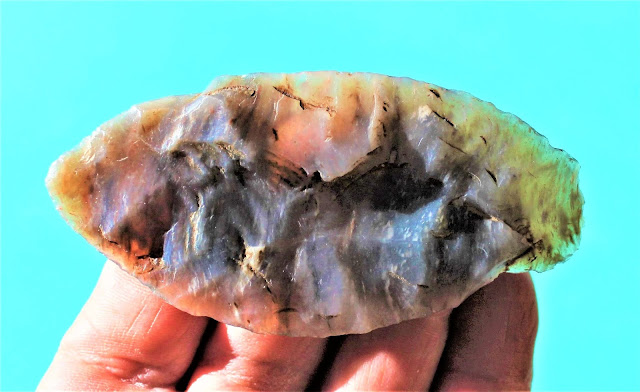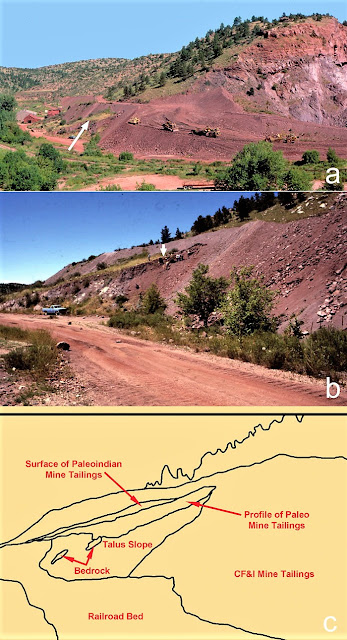 |
Figure One - Photo of a painting called Pre-Columbian Indian with Atlatl
by well-known western artist James Bama. |
In Part One of my series on the Atlatl and the SHADOWS on the TRAIL PENTALOGY, I discussed the overall concept of the atlatl weapon system and the advantages the thrower had by lengthening his or her throwing arm with an atlatl. With everything else being equal, lengthening the throwing arm by using a spear thrower or an atlatl increases
the velocity and distance of an airborne spear or dart. Higher velocity translates to better penetration which translates into more tissue and organ damage in the hunted prey. Of course, there is always too much of a good thing, and increasing the length of an atlatl past its optimal limit will significantly decrease the spear's accuracy.
Before we go any further with atlatls, I want to take you on a little elk hunt from my first book, SHADOWS on the TRAIL. Are you ready for that? In this particular scene, my main character Chayton is hunting with an atlatl. I assume that the atlatl weapon system was available to North American Paleoindians some 12,500 years ago. Circumstantial archaeological evidence indicates it was. Now, back to the hunt. A young elk bull and cow appeared out
of the trees, trotting out onto the open field. Chayton was at full alert. The
elk had yet to spot Chayton and they were heading straight towards the hunter.
The bull elk was leading the way with the cow elk following behind. They held
their heads high as they sniffed the breeze for predators. Chayton was downwind
and he realized this was what Hexaka planned the entire time.
Chayton’s
cocked his left throwing arm. He was
ready to heave the spear. He needed
the beasts closer. The bull was walking straight toward the hunter, but Chayton
did not like the chances of this throw. The bull had no vital organs exposed to
Chayton’s line of fire. Chayton
could throw the spear perfectly and still not kill the beast. The last thing
Chayton wanted to do was track down a wounded elk during the heat of the day across
country inhabited by wolves and mountain lions. He needed the elk to turn and
expose its side to his spear. Chayton
thought about moving his spot, but
one sound and both elk would be off and running in the opposite direction. If
the elk got any closer, they were bound to pick up Chayton’s scent.
Chayton searched the ground with
his off hand and found a rock. While his left arm kept the spear ready, he
hurled the rock off to his right. The rock bounced off a tree and rolled across
the ground. The bull elk turned to investigate the sound and in doing so, exposed
his side to the hunter. Chayton did not wait for any grass to grow; he hurled
the spear. The razor-sharp fluted spear tip popped loudly when it penetrated
the bull’s rib cage. The bull ran off as if nothing happened. Chayton watched
the bull elk plowing through the trees and vanishing from sight.
What happened with the elk? You will have to read the SHADOWS on the TRAIL to find out. Don't worry, the journey I take you on will be worth your time.
In part two, I am exploring the flight of the atlatl-launched spear or dart, but first a little housekeeping. In the following paragraphs, I will refer to the weapon that leaves the atlatl as a spear, even though some literature might refer to the weapon as a dart. In part two, atlatl spear and dart are synonymous.
The mechanics of an atlatl system depends on the flexibility of the spear. When the atlatl pushes the spear forward (figure three), energy is transferred from the atlatl and stored in the spear much like a spring. When the spear 'lifts off' from the atlatl, the stored energy is released and converted to additional velocity as it flies toward the target.
 |
Figure Three - The ingenuity of the mechanics behind the atlatl
is the stored energy within a flexed spear. |
Two concepts from physics help us to better understand the flight of an atlatl-launched spear. The first concept is momentum. Most of us have used the term momentum and generally understand who it works. Perhaps, we were talking about the momentum of our favorite sports
team or the momentum of a political candidate. In physics, momentum is defined as the tendency of an
object to continue moving in its original direction. Momentum
is an object’s resistance to stopping. An example of momentum is a rolling freight
train that suddenly needs to stop. A loaded freight train's momentum takes the train long past where it should have stopped.
How is momentum calculated? Momentum (P) is equal to the object's mass (M) multiplied times (x) the object's velocity (V). As an example, if a lighter atlatl spear is flying through the air at the same velocity as a heavier atlatl spear, the lighter spear has less momentum than the heavier spear. Put in a different way, less resistance is needed to stop a lighter spear if traveling at the same velocity as the heavier spear. Change either the mass or the velocity of an object and its momentum changes.
Momentum = P = M x V
As the equation above indicates, mass and velocity carry the same weight in calculating momentum. A slower-moving heavy spear can have the same momentum as a faster-moving light spear.
 |
Figure Four - Middle Archaic atlatl dart points from the high plains
showing size ranges. Longest point is 1.9 inches long.
John Bradford Branney Collection |
The second physics concept is kinetic energy which is defined as the energy
of an object in motion. The more kinetic energy a spear has, the more available
energy it has to penetrate the prey's hide, break any bones in its path, and push the projectile point and spear shaft further into the prey's body cavity.
Just like momentum, kinetic energy is defined using an object’s mass and velocity, but mass and velocity affect kinetic energy differently than momentum. While mass and velocity carry equal weight
in momentum, velocity is more important than mass with kinetic energy.
Kinetic energy (KE) is equal to one-half times mass (½ M) multiplied times (x)
velocity squared (V²).
Kinetic Energy = KE
= ½M x V²
To calculate kinetic energy, we divide the mass in half and square the velocity!
I mentioned earlier that a slower-moving heavy spear can have the same momentum as a faster-moving light spear. However, the faster-moving light spear has more kinetic energy than the slower-moving heavy spear. Velocity has a much higher influence on kinetic
energy than it does momentum. If the heavy spear and light spear are flying at the same velocity, the heavy spear has more kinetic energy because it has more mass. Although mass is important when it comes to spears, velocity has a bigger influence on distance, kinetic energy, and accuracy. The atlatl or the spear thrower portion of the weapon system has little influence on the size or mass of the spear, but it does have huge influence on increasing a given spear's velocity.
 |
| Figure Five - Paleoindians carrying atlatls and spears. |
Is a heavy or a light spear more lethal when it comes to hunting with an atlatl? Whittaker, Pettigrew, and Grohsmeyer
(2017) explored the relationship between heavy and light spears and suggested that Paleoindians who hunted large mammals such as mammoths or bison required heavier spears and projectile points. The spear had to be able to cut a hole through the animal's hide with enough momentum to reach its vital organs and/or cause lethal hemorrhaging. Close your eyes and imagine
hunting a gigantic mammoth with a light spear and small
projectile point. I would say that would be like “hunting a bear with a willow switch”. Although it is not prudent to hunt mammoths with undersized equipment, that same equipment might be suitable for hunting wary antelope on the plains where adding velocity improves both distance and accuracy.
It is logical to assume that Paleoindians customized their atlatl weapon systems for the type of prey they were hunting. If the targeted prey were mammoth or bison, the spears and projectile points might be heavier. If the targeted prey were deer, antelope, or mountain sheep, the spears and projectile points might be lighter and take advantage of increased velocity and distance. This is not any different than what modern game hunters do. You don’t see experienced hunters using rifles and cartridges designed for elephants on antelope or vice versa. That just doesn't make sense, and Paleoindians had to make sense if they wanted to survive.
Happy Hunting!
2017 Whittaker,
John C., Devin B. Pettigrew, and Ryan J. Grohsmeyer
Atlatl Dart Velocity:
Accurate Measurements and Implications for Paleoindian and Archaic Archaeology
in Paleoamerica, Vol. 3, No. 2, pp.
161-181. College Station.






















